Here’s an interesting fact – Approximately 3.5 billion searches take place on Google every single day! That’s a lot of people looking for content online. And if you’re able to meet these searchers with relevant, search engine optimized content, there’s nothing stopping you from climbing to the top of the search results. The key is to know the art and science of SEO content writing.
For most marketers out there, SEO content writing is mostly about keyword optimization, meta description writing, building backlinks, and other content SEO strategies. While on-page and off-page SEO are certainly an important part of the equation, SEO writing involves a lot more than this.
Search engines are designed to serve people, and help them find what they’re looking for. And that something is certainly not heavily-optimized, generic content that is stuffed with keywords. If you want to create content that is actually helpful, there needs to be a fine balance between the art and science of SEO content writing. The element of art will make the content more attractive and readable to humans, while the science of SEO content writing will focus on meeting the technical specifications of search engines. This article will tell you how you can find that balance.
TL;DR here’s a quick video on this article.
Here’s everything that will be covered in the upcoming sections.
- What is the difference between normal content writing and SEO content writing?
- How do I find a great SEO content writer?
Google ranking factors for better SEO content writing
A. Cover the basics of SEO content writing
- Turn keyword research into an art
- Plan at least 2–3 keywords for each blog
- Do competitor keyword analysis
- Incorporate keywords strategically
- Make the most of internal and external linking
B. Polish your SEO content writing
- Write for your audience
- Create a content outline
- Pay special attention to grammar and readability
- Don’t wait for inspiration to strike
- Edit and refine your content based on the 10-second rule
C. Content writing hacks for reader delight and SEO success
- Use power words to pack a punch with your writing
- Keep your sentences short
- Get rid of clutter and aim for more clarity
- Stay away from excessive use of adjectives and adverbs
- Consciously avoid clichés

What is SEO content writing?
SEO content writing is the process of creating content with the aim of attracting more traffic through search engines. It involves the use of solid on-page and off-page search engine optimization tactics and content creation best practices to build relevant and useful content for your target audiences.
The basic idea behind the SEO writing process is simple – to get your content to rank on top of the search engine results pages (SERPs). And you can work towards that by –
- Writing high-quality content
- Structuring the content effectively
- Targeting the right keywords
- Optimizing title tags and headers
- Adding meta description and title
- Ensuring that your content is in line with the audience’s search intent
- Internal linking
- External linking
- Building backlinks
There are many other SEO writing strategies that can increase the chances of your content appearing in search engine results when users search for related topics. What’s important here is to experiment with different SEO tactics to find what works best for your specific audience and niche. And then it’s a matter of developing a methodical approach to SEO content writing, which is what we’ll cover in this article.
What is the difference between normal content writing and SEO content writing?
The main difference between normal content writing and SEO content writing is the underlying purpose. With normal content writing, your entire focus is on making the content useful for your readers. But when it comes to SEO content writing, there is an additional focus on increasing the content’s organic visibility on SERPs. The purpose of SEO content writing is to attract new audiences by letting the search engines know you’re offering what the users are looking for. You would still be creating useful content for your readers, but you will also be leveraging search engines to fuel content discovery.
The great thing about SEO content writing is that besides improving search engine visibility and organic traffic, it can also help you deliver a better user experience. Since the focus is on satisfying user intent, the content created in the process will always be comprehensive, relevant, and high-quality. And when you’re providing your audience with this kind of content, your conversion rates will improve automatically.
How do I find a great SEO content writer?
An experienced SEO content writer can make your content marketing way more effective and help you climb search engine rankings. So, take the time to find someone who has great writing skills, understands the art and science of SEO, and can help you reach your goals.
While you can hire an in-house SEO content writer, this can be an expensive and time-taking process. The other option is an SEO content writing marketplace, where you can choose freelance SEO writers from a vast pool of global talent. Narrato Marketplace is one such content marketplace that has thousands of quality-vetted freelance writers. The smart algorithm matches you with the right freelance writer, who is well-versed with the best practices of writing SEO-friendly content. You can also choose to float the writing jobs to some preferred writers.

The great thing about Narrato Marketplace is that it offers fast content turnaround. This means that you wouldn’t have to wait for days, or consistently follow up with your writer to get your content piece. You’ll start receiving content within 24–48 hours of placing the content order. You can also get as many revisions as you need.
So whether you’re looking to scale up your SEO content writing, SEO copywriting, or blog SEO efforts, a content marketplace can make it all a lot easier.
Google ranking factors for better SEO content writing
Here’s the thing: If you want to see results from your SEO content writing efforts, experimenting with random SEO and content creation tactics will not do much for you. And even if it does, it’ll be quite a while before you start seeing results.
You need to develop your own content SEO strategy. And that starts by understanding how Google ranks your content, and what specific factors it takes into account while doing so. This will not only improve your SEO content writing efforts but also help you deliver a better user experience to your visitors.
When it comes to search engine results pages (SERPs), Google’s algorithm looks at a variety of factors and signals to determine where your web page appears. These are known as Google ranking factors.
Based on the information gained from Google announcements and research from SEO experts, there are more than 200 known Google ranking factors. In SEO content writing, though, the focus is mainly on on-page SEO, and some off-page SEO ranking factors. So here’s a brief look at them –
On-page SEO ranking factors
- Content Length: Long-form content pieces that cover a topic in-depth are usually preferred by the algorithm over superficial, shorter articles.
- Content Recency: Updated or recently published content is more likely to be shown higher on SERPs, especially for time-sensitive topics.
- Grammar & Spelling: Content pieces free of spelling errors and grammatical mistakes would indicate high quality.
- Readability: Content readability is another important determiner of content quality for Google.
- Keyword in title tag: This is a crucial on-page SEO signal for Google, and the algorithm prefers when the keyword is included at the start, rather than the end of the title tag.
- Keyword in description tag: Although SEO meta description is not a direct ranking factor, adding the keyword in it is known to improve your content’s click-through rate.
- Keywords in headings and subheadings: The H2 and H3 tags help Google understand the structure of the content, so adding the keyword here can be a plus.
- Keyword prominence: Including the primary keyword in the opening 100 words of the content has been linked to higher Google rankings.
- TF-IDF: This helps Google figure out which words are relevant to the topic. It examines how many times a word appears on a page (term frequency, or TF) and how often it’s expected to show up on any regular page (inverse document frequency, or IDF).
- Linked table of contents: This makes it easier for Google to understand the scope of content, and can also help you get site links.
- Numbered lists and bullets: Content with bullets and numbered lists performs better on Google because it enhances the readability of the content.
- LSI keywords: Latent Semantic Indexing (LSI) keywords also help Google understand what your content is about. These keywords should ideally feature in the description and title tags and throughout the content.
- Page category: Specifying the page category helps Google understand its relevancy.
- Topic coverage: With this ranking factor, Google examines how well your content covers a topic.
- URL length: Google tends to prefer concise and shorter URLs, with the primary keyword added in.
- Page load speed: Page load speed directly affects user experience, which makes it an important ranking factor for Google too.
- Images, videos, and multimedia elements: Adding multimedia elements to your content helps in improving its quality.
- Image optimization: Google takes into consideration whether you’ve added the image title, file name, alt text, caption, and/or description.
- Content updates: The frequency of content updates tells the search engine how fresh it is.
- Outbound links: Google takes into account the quality of your outbound link (whether it links to high-authority resources). It also takes into account the relevancy of outbound links, and whether it ties to your topic. The number of outbound links is also important here, as too many can hurt your search rankings.
- Internal links: The relative importance of a page is judged by the amount of internal links it has.
- Supplementary content: Google also examines whether the content provides any additional material to the readers that would be helpful for them.
- References: Content with a list of references is indicative of the content’s authority.
- Duplicate content: If your content is flagged as plagiarised, it will negatively impact your search rankings.
- Syndicated content: Content pieces that are scraped or copied from indexed pages might not get indexed by Google.
- Broken links: If your content has too many broken links, Google might consider yours an abandoned site.
- HTML errors: A well-coded page is an important quality signal for Google. If there are many HTML errors in your content page, it might not rank well.
Off-page SEO ranking factors
- TrustRank: This is the rank Google attributes to your site after calculating its trustworthiness.
- SSL certificate: Having an SSL certificate on your site often helps Google break up a tie between two equal search results.
- Link authority: A strong link authority shows Google that your website is trusted within the industry.
- Link relevancy: Google takes into account the thematic connection between incoming links and your site’s content.
- Number of referring domains: The number of domains that directly backlink to your site helps in boosting your site’s authority.
- Do-follow links: These are links you mark for the search engines to crawl and index. They contribute to your domain authority.
- No-follow links: These are meant to generate more traffic and diversify the link profile.
- Anchor text: This helps Google associate specific keywords/key phrases with URLs.
- Brand citations and mentions: These are implied links that reference your content, but without a hyperlink. More high-quality brand mentions indicate the trustworthiness of your content to Google.
- Social shares: The number of shares your content gets on social media platforms is also an important ranking factor for Google.
- Reviews: Customer reviews don’t only influence the perception of your target audience. These reviews are an indication to Google that your site is reliable.
- Mobile-friendliness: Google follows a mobile-first indexing policy, which means that mobile-friendly content will always perform better.
- E-A-T: Content that gets a high E-A-T ranking tends to perform well on search.
What is Google E-A-T?
Before we get to SEO content writing tips, you should know about the one thing that has remained consistent through all the Google algorithm updates: E-A-T.
Expertise Authority and Trust, or E-A-T was added to Google’s Search Quality Guidelines way back in 2014. Although it is not a ranking factor in technical terms, it does play a huge part in determining your search rankings. It forms the basis on which search evaluators judge and rate the quality of content.
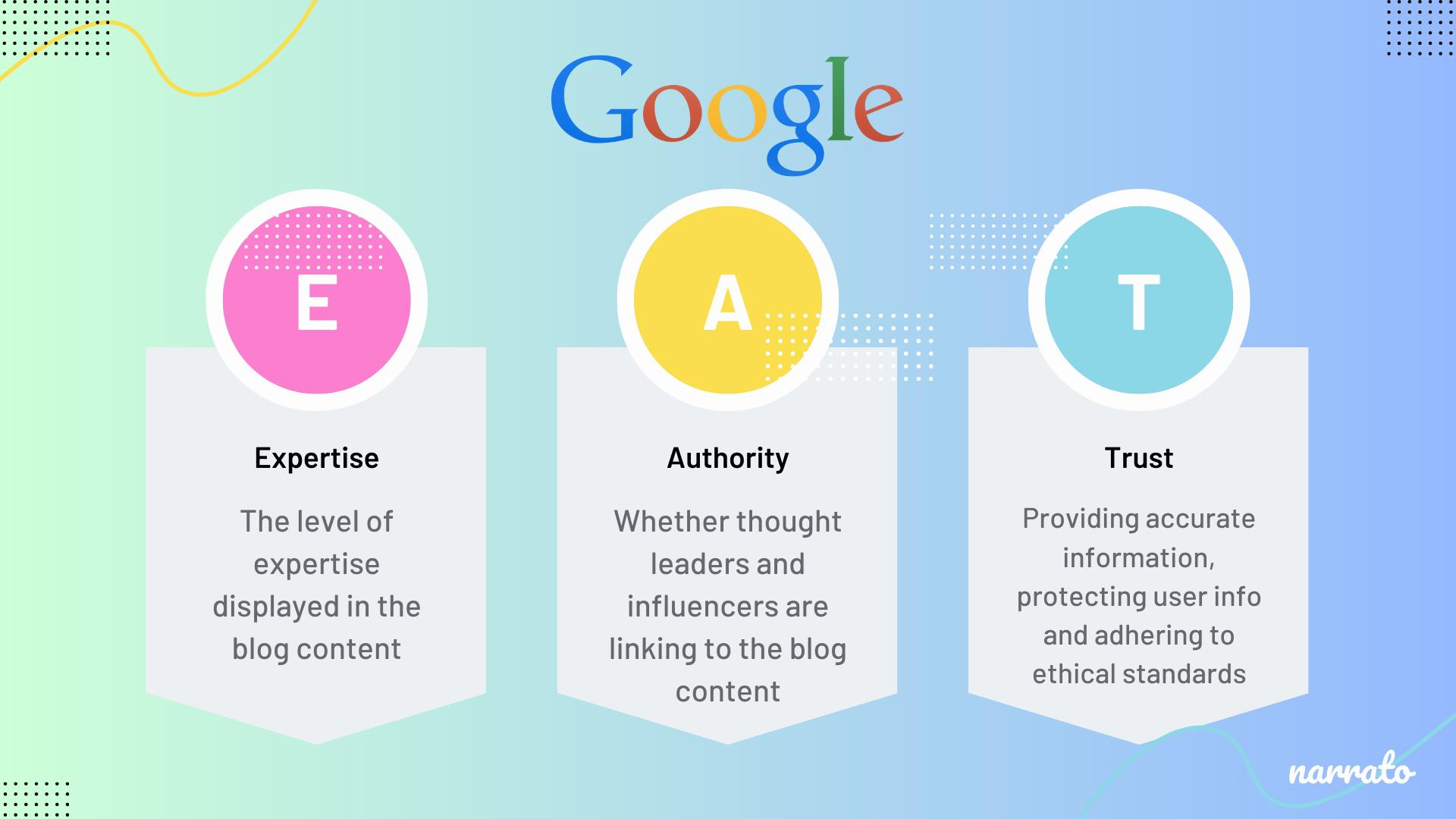
In late 2022, another element was added into the mix to create E-E-A-T, or ‘Double-E-A-T’. This additional E stood for Experience. The purpose of this additional E is to determine whether a piece of content was created after having gained some level of experience with the topic.
So, if you want to qualify for Google’s E-E-A-T, you would have to ensure that your content –
- Shows expertise
- Helps readers
- Is updated regularly
- Exhibits subject authority
- Provides accurate information
- Gives practical suggestions or information
With the basics of SEO covered, let’s take a look at how you can incorporate this knowledge into your content writing efforts.
SEO Content Writing Tips
You’ll be able to enjoy true success in the digital space when the art of writing and the science of SEO are in perfect balance. Writing good SEO content is all about combining topical expertise, writing techniques, and SEO best practices. Here are some tips that can help you with that –
A. Cover the basics of SEO content writing
Whether you are new to SEO or looking to refresh your knowledge, this section will provide you with the necessary insights to lay the right foundation for the SEO content writing process. Let’s start by tackling some of the basics first.
1. Turn keyword research into an art
If you want your content to be found, and your message to stand out among the digital clutter, you’ll need to include relevant keywords in the content you write. And that starts with developing a fool-proof keyword research strategy and using the right SEO tools.
To develop your keyword research strategy, you can test out different marketing guides available online, such as this 5-step guide to keyword research from Digital Marketing Institute. Find out what works for you, and pick the best elements from different guides to build your own keyword research plan.
We, at Narrato, find it useful to do fresh keyword research every month, because search trends have a tendency to change from time to time. Then it’s a matter of deciding content topics, picking out primary/secondary keywords, and building our content calendar around that. Narrato’s AI-powered SEO content brief makes this simpler for us. All we have to do is provide the tool with a seed keyword, and it generates a complete content brief based on that, with a comprehensive list of related keywords.

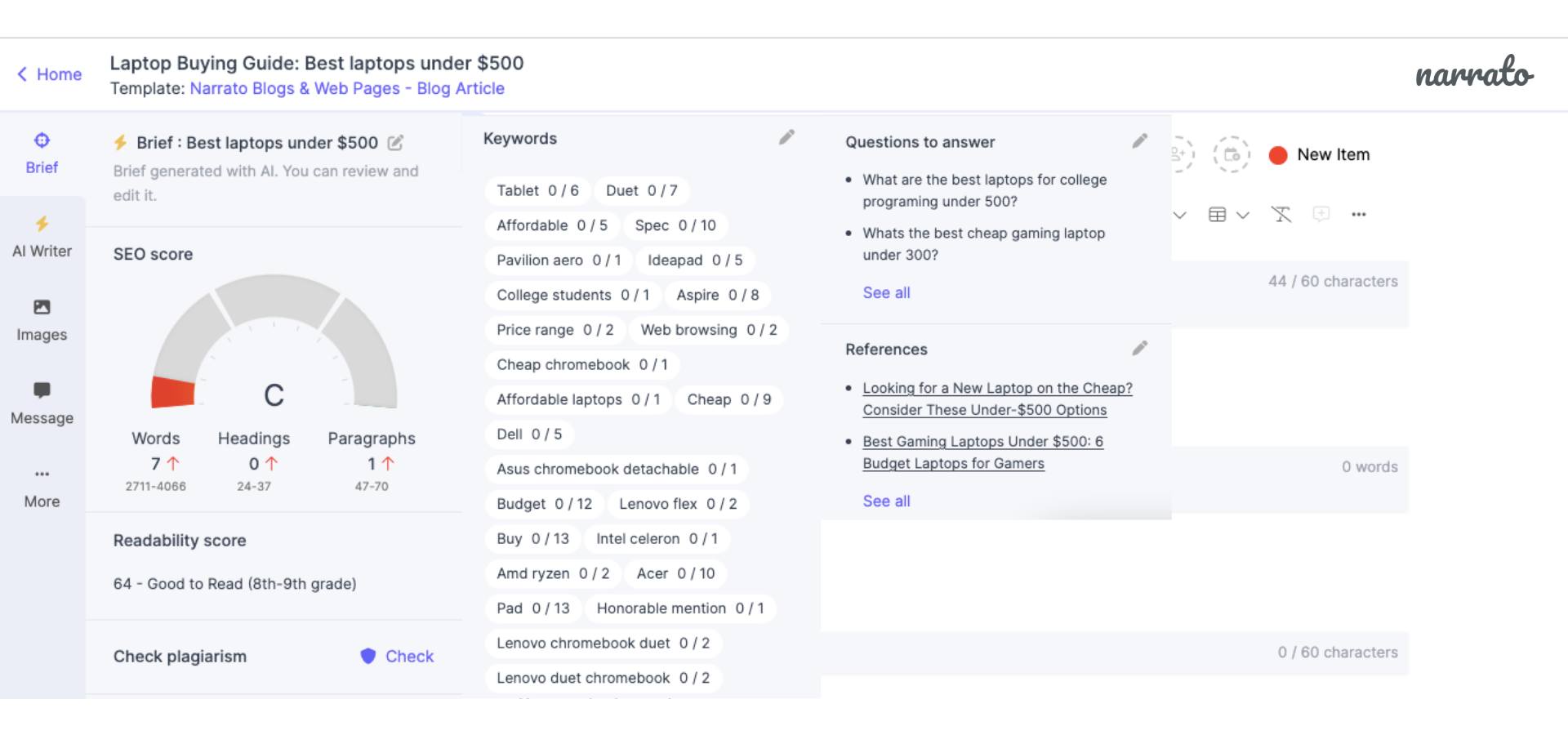
Besides a keyword list, you would also get target word/heading/paragraph counts, a list of references, and questions to answer in the content. It also gives you an SEO score that visually describes how well your content is optimized according to the given SEO parameters.
We also have our own content calendar tool, which makes it easier to map out the content plan and track the status of content projects.

2. Plan at least 2–3 keywords for each blog
When you’re building your keyword plan, decide the number of blogs you want to target in a month, and pick 2–3 keywords for each blog topic. Approach this process by first identifying your target audience’s search intent, and then looking into the search volume. For the pillar pages, it is best to pick broader search terms, while long-tail keywords work better for cluster topics.
You can find your target keywords using the Search Keyword template in Narrato’s AI Content Assistant. You can simply provide your topic/product name/theme and the tool will generate a list of relevant keywords with average search volumes and competition.

SearchVolume by SEO.ai is also an excellent free tool to check the search volume of your target keywords. And if you’re looking for a dedicated long-tail keyword finder, you might want to give Keywords Heaven a try.
3. Do competitor keyword analysis
If you want to outrank your competitors, study them first. Try to zero in on their keyword strategy. Find out what keywords your competitors are ranking for, but you’re not. Take a look at the content that’s showing up for those keywords, and see if there’s any way you can create something even better. This is also a good time to identify gaps in your competitors’ keyword strategy. For instance, there might be some long-tail keywords that they are not targeting but are relevant to your business.
SpyFu can be a good tool to aid in competitor research. When you input a competitor page’s URL into the search bar, it will provide you with a comprehensive overview of the top keywords they are ranking for, their inbound links, and also their competitors. It also comes with an option to compare your domain with the competitor’s domain.
4. Incorporate keywords strategically
To make the most out of SEO content writing, you have to learn the art of strategically incorporating keywords into your content. Don’t forget to add the primary keyword in the first 100 words, title tag, meta description, header tags (H1, H2, H3), image alt descriptions, image file names, and URL. Also, add them in FAQs and relevant bullet points to increase your chances of getting a featured snippet.
Avoid keyword stuffing at all costs. It might have worked some years back, but overly optimized content can actually harm your search rankings. Keyword stuffing disrupts the reading flow and makes the content sound unnatural. So it’s best to look for ways to incorporate keywords so that they fit naturally into the content. Rather than writing all your content and then adding keywords, keep a list of target keywords ready and continue building your content to include them.
The SEO content brief generator on Narrato AI Content Workspace comes with another feature for keeping track of keyword optimization. When you write your content on Narrato’s powerful content editor, you’ll get dynamic updates on keyword count in a tab on the left. This makes it easier to add relevant keywords to your content naturally.

You can also try ChatGPT for building effective content briefs, but it will require using the right ChatGPT prompts for SEO.
5. Make the most of internal and external linking
The purpose of internal and external links is to provide additional value to your readers. But, just because it’s good for SEO, don’t start adding links for the sake of it. These links should add depth and relevance to your content, and should fit into your overall content strategy naturally. And the anchor text for both should be keyword-focused and relevant to the linking page.
When you’re adding external links, make sure that you link to high-authority sources. This shows that you have done thorough research, and it also adds credibility to your content. For identifying high-authority pages, you can install the MozBar, which comes in the form of a Chrome browser extension. It will give you a brief overview of the domain authority (DA), page authority, and spam score of every webpage you visit.
B. Polish your SEO content writing
After the basics are covered, think about how you can perfect the writing process. Here are some tips to write SEO content more effectively –
1. Write for your audience
You might be adding all the SEO elements, and other bells and whistles to your content, in the hopes that it would rank well. But if your writing and content do not appeal to your audience, no amount of keyword optimization will improve the ranking of your blog posts.
Before you get down to writing, create your blog audience persona. This will help you better identify the problems, needs, and preferences of your target audience. It will also help you determine what tone of voice and style of writing will appeal most to them.
You can use Narrato’s ChatGPT integration to create an audience persona for the topic at hand. Just provide it with a prompt that goes something like – “Write an audience persona for [Topic}. Specify the audience’s search intent, the tone of voice, and the style of writing they would prefer.” You can create multiple audience personas for the topic in the same way.
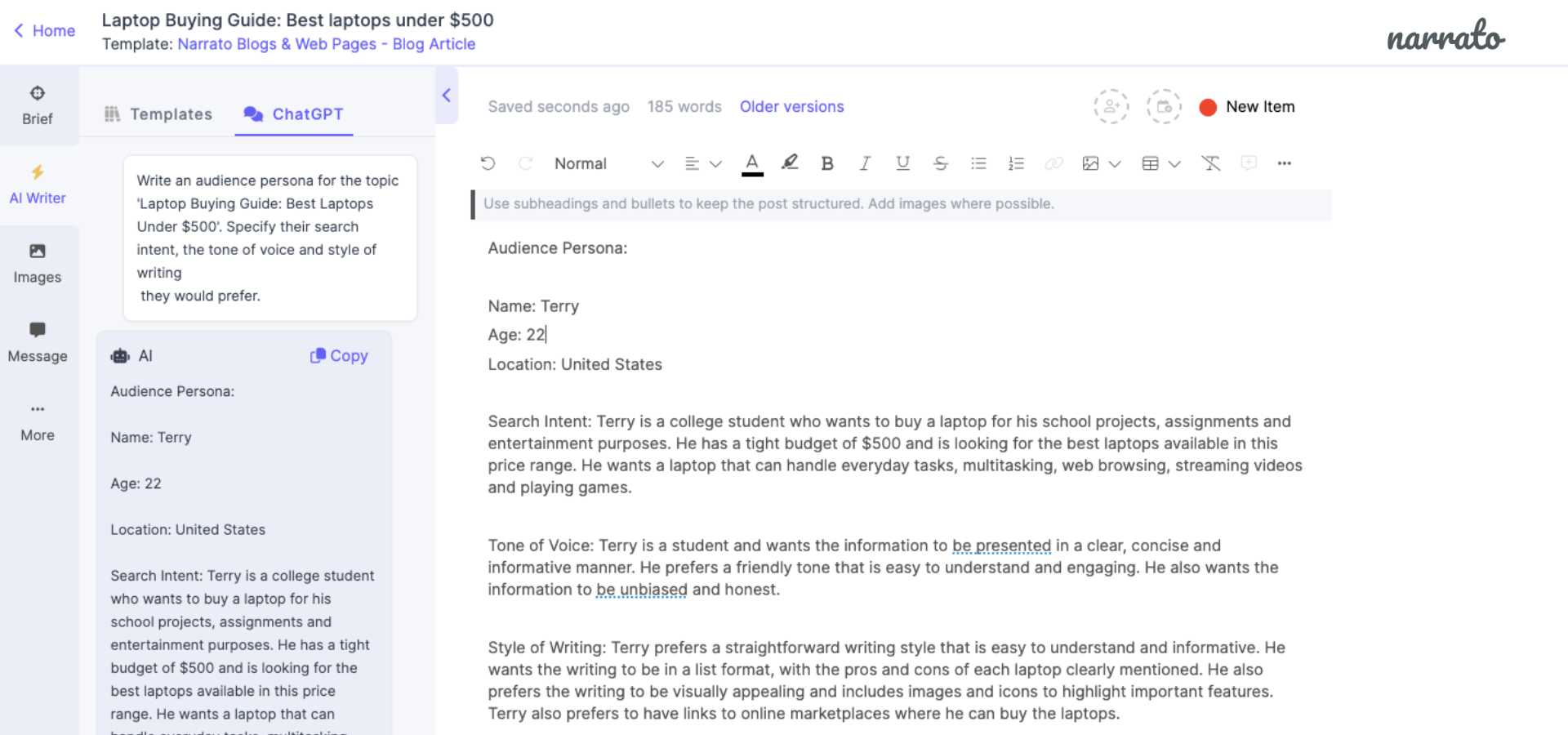
2. Create a content outline
Before you start the process of writing SEO content, it’s always best to create a content outline for the topic. Having a content outline in place makes it easier to organize your thoughts and structure your content. When you’re writing for SEO purposes, stream-of-consciousness writing will not be the best idea. A content outline with provide you with a roadmap and clear direction to build your content.
Narrato’s AI writer has a dedicated use case for building blog post outlines. All you have to do is provide the tool with the topic, select your tone and audience, and click generate. It creates a list of sub-headings that you can then use to build your research.
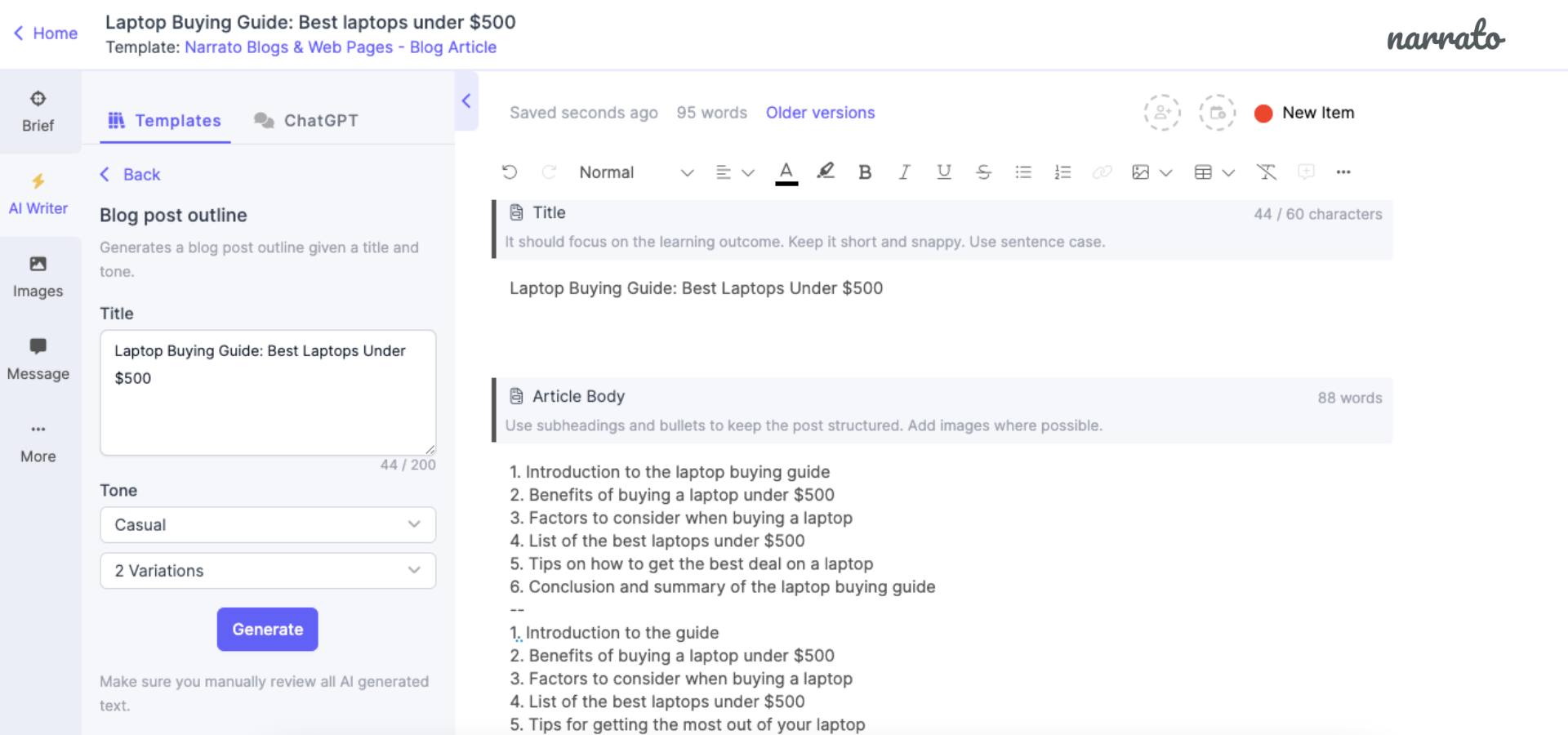
3. Pay special attention to grammar and readability
We’ve already covered that your content’s grammar and spelling is an important ranking factor for Google. That’s because any sloppy grammatical/spelling errors can bring down your content credibility almost instantaneously. It will make your content seem unreliable and unprofessional, and the readers will bounce quickly.
Grammar checker tools can help you here. If you’re using Narrato’s content editor, it will identify grammar, spelling, and readability mistakes, and provide suggestions accordingly. It will also provide you with a readability score.
To improve your content’s readability, make sure to –
- Keep your sentences and paragraphs shorter
- Use bullet points and numbered lists to make the content more scannable
- Break up the text with relevant images, infographics, or any other visual content
4. Don’t wait for inspiration to strike
There will be times when you’ll be faced with writer’s block. And it’s even more stressful when you’re working on a content piece with a tight deadline. An AI writer can help you work through these creative blocks. Instead of waiting for inspiration to strike, take the assistance of an AI writing assistant to spark new ideas. Here’s a comprehensive guide for doing SEO writing with AI.
Let’s say, you can’t think of an interesting way to conclude your content piece. If you’re using Narrato’s AI writer, you can simply choose the ‘blog post conclusion’ use case, provide the tool with the outline of your blog, and get an AI-generated conclusion. All that is left is to refine and polish the content so that it fits naturally into your content piece. Narrato offers several other use cases for the purpose, whether you’re working on a blog, copy, email, or even the textual component of video content.
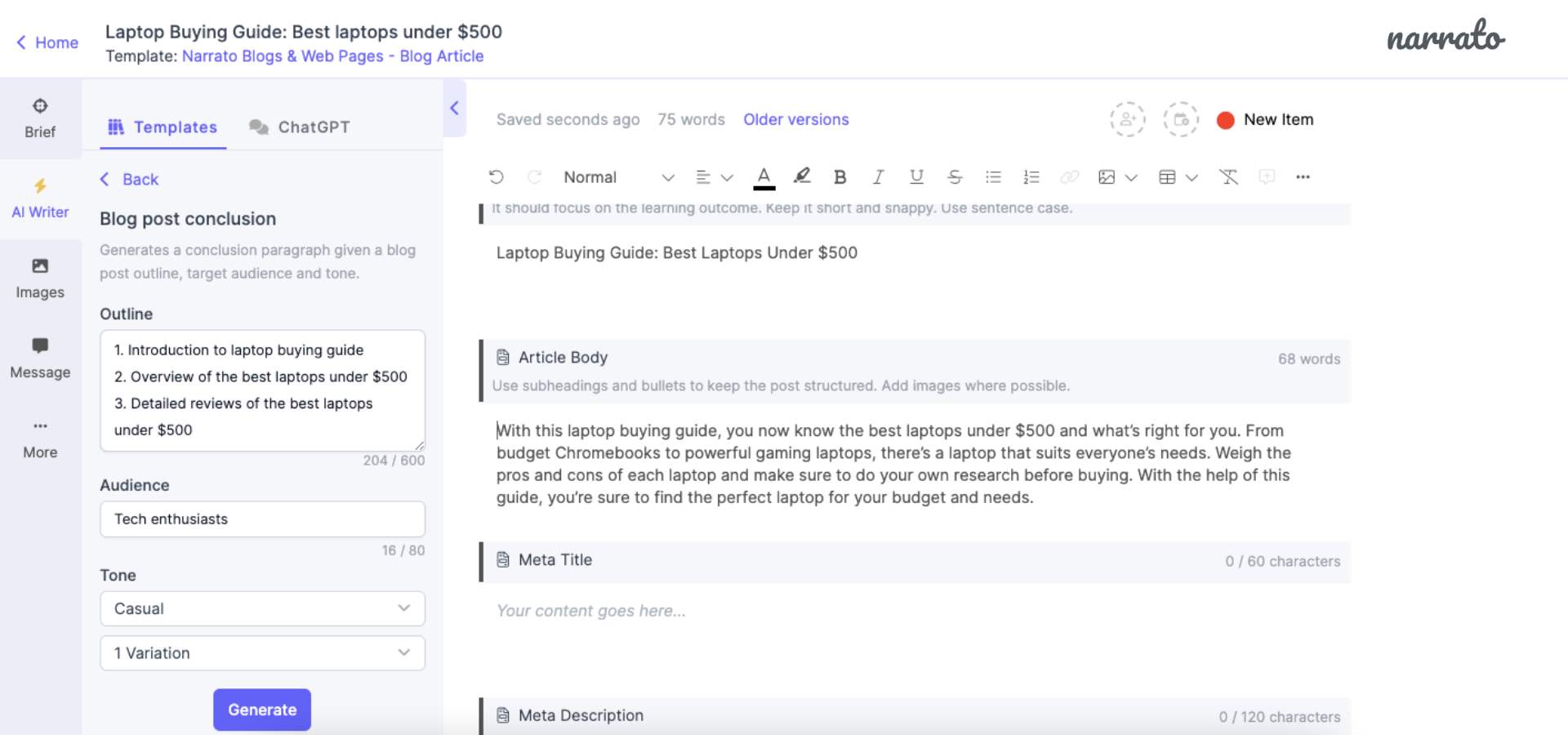
5. Edit and refine your content based on the 10-second rule
Follow a 10-second rule for editing and polishing your content. The basic principle of this rule is that every section should grab the readers’ attention within the first 10 seconds. And this is especially important for the introductory paragraph and the meta description of your content piece. By following this simple rule, you’ll be able to see a marked improvement in your content quality.
C. Content writing hacks for reader delight and SEO success
Keep in mind these few SEO content writing tips to enhance your content’s appeal to both human readers and search engines alike.
1. Use power words to pack a punch with your writing
Start your paragraphs and sentences with ‘power’ words that spice up your content and bring your ideas to life. Make sure that the strongest sentences appear at the very beginning or close to the end. This way, the most persuasive and impactful writing is placed in front of the reader first, urging them to keep reading. And the more in-depth material is placed in the middle.
2. Keep your sentences short
The best way to improve the readability of your content is by keeping the sentences shorter. With shorter sentences, you give your reader’s mind a chance to breathe. The idea is to use one sentence to convey one idea.
You can introduce a few longer sentences into the mix too if most of your content consists of shorter sentences. This helps in creating a rhythm, which is something most readers enjoy.
3. Get rid of clutter and aim for more clarity
If there’s one thing that kills your audience’s enthusiasm to read, it is fluff. Skip any words or sentences that don’t contribute anything to the text. Aim for simplicity and get straight to the point. Also, make sure that you bring more clarity to the subject. Have a clear vision, and build your content with an end goal in mind.
4. Stay away from excessive use of adjectives and adverbs
Using adjectives and adverbs excessively can make the content convoluted and difficult to understand. It overshadows the main message you are trying to convey. Besides, it also makes your writing unnecessarily wordy and lengthy.
5. Consciously avoid clichés
Relying on clichés makes your writing boring and unimaginative. And you miss an opportunity to engage your audience with your creativity. Use fresh and imaginative descriptions and expressions that evoke stronger emotions and keep readers interested.
Wrapping Up
SEO content writing wouldn’t seem so difficult when you learn how to strike a perfect balance between the art and science of the SEO writing process. The art lies in crafting engaging, valuable, and well-structured content that addresses user intent and fulfills their needs. And the science involves optimizing your content with relevant keywords, following best practices for on-page SEO, and providing an exceptional user experience.
Always remember – SEO content writing is not just about appeasing search engines; it’s about delivering value to your audience. And that is what we’ve tried to help you with. With the knowledge gained from this article, you can master the art and science of SEO content writing, and continue to provide your audience with useful and valuable content.




